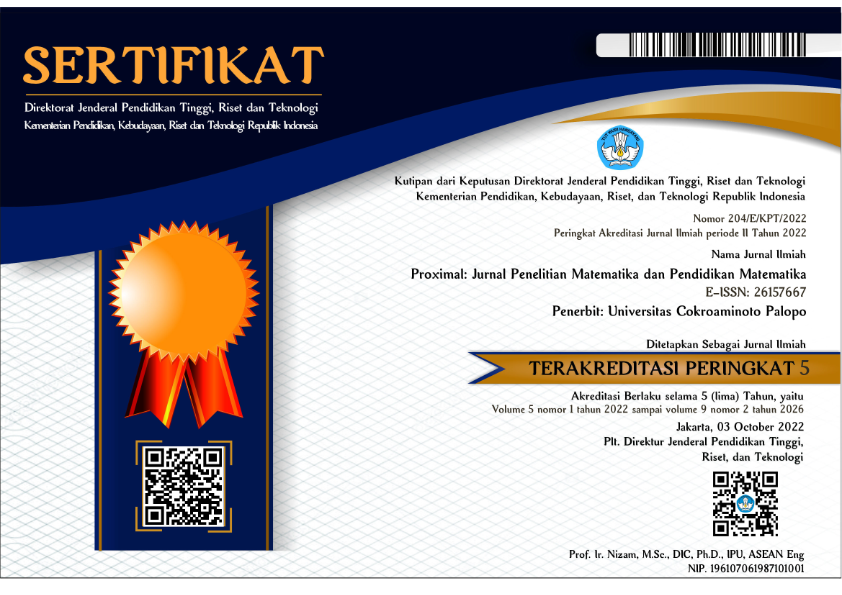Penggunaan GeoGebra pada Materi Geometri dalam Mendorong Pemahaman Peserta Didik
DOI:
https://doi.org/10.30605/proximal.v8i3.6280Keywords:
Geogebra, Geometri, Hasil Belajar, Respon Siswa, Pembelajaran MatematikaAbstract
Pemahaman konsep geometri masih menjadi tantangan bagi banyak peserta didik karena sifatnya yang abstrak dan visual. Penelitian ini bertujuan untuk mengetahui pengaruh penggunaan GeoGebra terhadap hasil belajar peserta didik pada materi geometri serta menganalisis respon peserta didik terhadap penggunaannya. Penelitian menggunakan desain eksperimen kuasi dengan bentuk non-equivalent control group design. Sampel terdiri dari dua kelas VIII di MTs Negeri 1 Maros tahun pelajaran 2025/2026, yaitu kelas eksperimen yang menggunakan GeoGebra dan kelas kontrol yang menggunakan metode konvensional. Data dikumpulkan melalui posttest dan angket respon, kemudian dianalisis menggunakan uji-t dan analisis deskriptif. Hasil penelitian menunjukkan bahwa terdapat perbedaan yang signifikan antara hasil belajar kelompok eksperimen dan kontrol (p = 0,004) dengan nilai effect size yang besar (Cohen’s d = 0,865). Selain itu, respon peserta didik terhadap penggunaan GeoGebra berada dalam kategori positif dengan rata-rata skor 81,91. Dapat disimpulkan bahwa GeoGebra efektif digunakan dalam pembelajaran geometri karena mampu meningkatkan hasil belajar dan mendapat respon positif dari peserta didik
Downloads
References
Anggreni, D., Busrah, Z., & Gusniwati. (2022). Diagnosis kesulitan belajar matematika materi relasi dan fungsi pada siswa MTs kelas VIII. Pi: Mathematics Education Journal, 5(1), 1–6. https://doi.org/10.21067/pmej.v5i1.5282
Arifin, E. Y., & Hamdani. (2017). Analisis kesulitan belajar siswa pada materi bangun ruang sisi lengkung di SMP. Jurnal Pendidikan dan Pembelajaran Khatulistiwa, 6(4).
Bahri, B., Najamuddin, N., Kesuma, A. I., & Jumarni, J. (2023). Pengaruh media Google Slide dalam pembelajaran sejarah. Jurnal Sejarah, 6(1), 157–166. https://doi.org/10.17977/um0330v6i1p157-166
Dove, A. (2011). Teaching geometry in a 1:1 classroom: High school teachers' instructional practices while participating in professional development (Doctoral dissertation, North Carolina State University). NC State University Libraries. http://www.lib.ncsu.edu/resolver/1840.16/7000
Himmi, N., & Hatwin, L. B. A. (2018). Pengembangan modul sistem pertidaksamaan dua variabel berbasis GeoGebra terhadap kemampuan visual thinking matematis siswa kelas X. Pythagoras: Jurnal Program Studi Pendidikan Matematika, 7(1), 35–46. https://doi.org/10.33373/pythagoras.v7i1.1208
Istofany, M. A. B., Negara, H. R. P., & Santosa, F. H. (2024). Analisis penggunaan teknologi dalam pembelajaran matematika untuk meningkatkan keterampilan berpikir kritis pada mahasiswa. Jurnal Ulul Albab, 28(1), 1–14. https://doi.org/10.31764/jua.v28i1.23325
Jones, K. (2020, September). Re imagining geometry education in schools. Dalam H.-S. Siller, W. Weigel, & J. F. Wörler (Ed.), Beiträge zum Mathematikunterricht 2020: Proceedings of the 54th Annual Meeting of the German Society for the Didactics of Mathematics (GDM) (hlm. 31–38). Münster: WTM Verlag. https://doi.org/10.17877/DE290R-21408
Nasir, A. M. (2016). Statistik Pendidikan. Yogyakarta: Media Akademi.
Purwasi, L. A., & Fitriyana, N. (2020). Pengembangan lembar kerja peserta didik (LKPD) berbasis higher order thinking skill (HOTS). Aksioma: Jurnal Program Studi Pendidikan Matematika, 9(4), 894–908. https://doi.org/10.24127/ajpm.v9i4.3172
Rifanti, D. N., Septia, T., & Handayani, U. F. (2023). Dampak penggunaan media pembelajaran video animasi terhadap respon pembelajaran matematika peserta didik kelas XI SMK. Jurnal Inovasi Pembelajaran Matematika: PowerMathEdu, 2(3), 261–268. https://doi.org/10.31980/pme.v2i3.1428
Sugandi, E. (2021). Kesalahan penyelesaian soal geometri transformasi berdasarkan gaya belajar: Studi kasus mahasiswa calon guru matematika. UNION: Jurnal Ilmiah Pendidikan Matematika, 9(1), 71–80. https://doi.org/10.30738/union.v9i1.9293
Sunzuma, G., Chando, C., Gwizangwe, I., Zezekwa, N., & Zinyeka, G. (2020). In-service Zimbabwean teachers’ views on the utility value of diagrams in the teaching and learning of geometry. LUMAT: International Journal on Math, Science and Technology Education, 8(1), 1–18. https://doi.org/10.31129/LUMAT.8.1.1316
Downloads
Published
How to Cite
Issue
Section
License
Copyright (c) 2025 A. Muhajir Nasir, Nur Aisyah, Nirfayanti, Dedy Setyawan, Rahmawati Patta

This work is licensed under a Creative Commons Attribution 4.0 International License.
In submitting the manuscript to the journal, the authors certify that:
- They are authorized by their co-authors to enter into these arrangements.
- The work described has not been formally published before, except in the form of an abstract or as part of a published lecture, review, thesis, or overlay journal.
- That it is not under consideration for publication elsewhere,
- That its publication has been approved by all the author(s) and by the responsible authorities – tacitly or explicitly – of the institutes where the work has been carried out.
- They secure the right to reproduce any material that has already been published or copyrighted elsewhere.
- They agree to the following license and copyright agreement.
License and Copyright Agreement
Authors who publish with this journal agree to the following terms:
- Authors retain copyright and grant the journal right of first publication with the work simultaneously licensed under Creative Commons Attribution License (CC BY 4.0) that allows others to share the work with an acknowledgment of the work's authorship and initial publication in this journal.
- Authors are able to enter into separate, additional contractual arrangements for the non-exclusive distribution of the journal's published version of the work (e.g., post it to an institutional repository or publish it in a book), with an acknowledgment of its initial publication in this journal.
- Authors are permitted and encouraged to post their work online (e.g., in institutional repositories or on their website) prior to and during the submission process, as it can lead to productive exchanges, as well as earlier and greater citation of published work.















